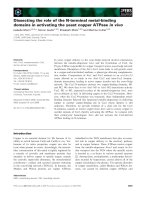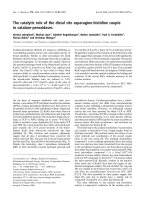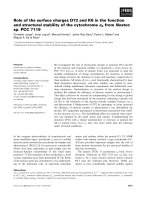Role of the survival proteins hsp27 and survivin in a small molecule sensitization to TRAIL mediated apoptosis 1
Bạn đang xem bản rút gọn của tài liệu. Xem và tải ngay bản đầy đủ của tài liệu tại đây (7.82 MB, 104 trang )
ROLE OF THE SURVIVAL PROTEINS HSP27 AND
SURVIVIN IN A SMALL MOLECULE SENSITIZATION
TO TRAIL-MEDIATED APOPTOSIS
GRÉGORY MELLIER
(B.Sc., M.Sc., Claude Bernard University – Lyon 1, Lyon, France)
A THESIS SUBMITTED FOR THE DEGREE OF DOCTOR OF
PHILOSOPHY
YONG LOO LIN SCHOOL OF MEDICINE
DEPARTMENT OF PHYSIOLOGY
NATIONAL UNIVERSITY OF SINGAPORE
2010
i
ACKNOWLEDGMENTS
“If we knew what it was we were doing, it would not be
called research, would it?”
Albert Einstein
First and foremost, I would like to thank my supervisor, Prof. Shazib Pervaiz, for
giving me the opportunity to join his lab and embark on this PhD. Thank you for your
constant support, both in and out of the lab, throughout these last years.
Of course, huge thanks to all my labmates, both past and present, for making the lab
such a lively place.
To my friend and flatmate, Dr. Andrea Lisa Holme for her encouragements during the
writing of this thesis and her help during the past few years.
To Dr. Alan Prem Kumar and the rest of the gang for their friendship.
And last but not least, I would like to thank my family for their never ending support
despite the distance. Dad, thank you for believing in me.
ii
To my mother
iii
TABLE OF CONTENTS
Acknowledgments i
Table of contents iii
Summary ix
List of tables xi
List of Figures xii
List of Abbreviations xiv
Introduction 1
1. General apoptotic mechanisms 1
1.1. Apoptosis and necrosis 1
1.1.1. Necrosis 1
1.1.2 Apoptosis 1
1.1.2.1. Characteristics of apoptosis 2
1.1.2.2. Apoptosis is an evolutionary conserved mechanism 3
1.1.2.3. Physiological role of apoptosis 3
1.2. Mechanisms of apoptosis induction 4
1.2.1. Molecular players in apoptosis 6
1.2.1.1. Caspase family 6
1.2.1.2. Inhibitors of apoptosis 8
1.2.1.2.1 Survivin 11
1.2.1.3. Bcl-2 family 13
1.2.2. Mitochondrial, or intrinsic, pathway 14
1.2.3. Death receptors, or extrinsic, pathway 17
1.2.3.1. Ligands and receptors of the TNF-! superfamily 17
1.2.3.2. Signalization pathway 18
1.2.3.3. Activation of the mitochondrial pathway by the death receptors 19
2. TRAIL 21
2.1. TRAIL 21
2.2. TRAIL receptors 21
2.3. TRAIL signal transduction 22
iv
2.4. TRAIL as a therapeutic modality 24
2.5. TRAIL resistance in cancer 26
2.5.1. Resistance in the death receptor pathway 28
2.5.1.1. Resistance involving the death receptors 28
2.5.1.2. DISC components: c-FLIP and caspase-8 29
2.5.2. Resistance in the mitochondrial pathway 29
2.5.2.1. Upstream of the mitochondria: the Bcl-2 family 30
2.5.2.2. Downstream of the mitochondria: the IAP family 30
2.6. Strategies to restore cancer cell sensitivity to TRAIL 31
2.6.1. Modulation of the extrinsic pathway 31
2.6.1.1. Up-regulation of death receptors 32
2.6.1.2. Oligomerization of DRs 32
2.6.1.3. Down-regulation of c-FLIP 33
2.6.2. Modulation of the intrinsic pathway 33
2.6.2.1. Down-regulation of IAPs 34
2.6.2.2. Down-regulation of the anti-apoptotic Bcl-2 proteins 34
2.6.3. Simultaneous modulation of extrinsic and intrinsic pathways 35
2.7. Pre-clinical and clinical evaluation of TRAIL 36
2.7.1. Recombinant human TRAIL 36
2.7.2. Agonistic antibodies 37
2.7.3. Combinational therapies 37
3. Heat Shock Proteins and Hsp27 39
3.1. High molecular weight Hsps 39
3.1.1. Hsp90 40
3.1.2. Hsp70 40
3.1.3. Hsp60/10 41
3.2. Small Heat Shock Proteins 41
3.2.1 Cellular characteristics 43
3.2.1.1. Cellular localization 43
3.2.1.2. Expression/Regulation 43
3.2.1.2.1. Expression following a cellular stress 44
3.2.1.2.2. Pathological expression 45
3.2.1.2.3. Physiological expression 46
3.2.2. Biochemical characteristics 46
v
3.2.2.1. Structure 47
3.2.2.1.1. Primary/Secondary 47
3.2.2.1.2. Tertiary/Quaternary 49
3.2.2.2. Phosphorylation 50
3.2.2.2.1. Phosphorylation signaling 51
3.2.2.2.2. Effect of phosphorylation on the quaternary structure 51
3.2.3. Cellular functions 52
3.2.3.1. Protection against heat shock and oxidative stress 54
3.2.3.2. Cytoskeleton protection 57
3.2.3.3. Anti-apoptotic functions 57
3.2.3.4. Chaperone activity 60
3.2.3.4.1. Mode of action 60
3.2.3.4.2. Importance of the large oligomers for the chaperone activity. 61
3.2.3.4.3. Dynamics of oligomers 63
3.2.3.4.4. Additional role of Hsp27 chaperone activity 63
4. LY303511 65
Material and Methods 68
Cell line 68
Reagents and chemicals 68
Antibodies 69
Plasmids and siRNAs 70
Transient transfection of plasmids 70
Transient silencing of protein expression 71
Cell viability assay 71
Colony forming assay 72
Laser Scanning Cytometry (LSC) 72
Cell cycle, PI uptake 72
Mitochondrial membrane potential measurement and mitochondrial
aggregation 73
Caspase activity 73
PP2A activity assay 74
Western blot analysis 74
Cellular fractionation 75
vi
Soluble / Insoluble fractions 75
Mitochodrial fractionation 76
Nuclear fractionation 76
Non-radioactive Electro-Mobility Shift Assay (EMSA) 77
Chromatin Immuno-Precipitation (ChIP) 77
Reverse-Transcriptase Polymerase Chain Reaction 79
Total RNA extraction 79
RT-PCR 79
Hsp27 oligomerization analysis 80
In vivo chaperone activity assay 81
Densitometry 82
Statistical analysis 82
Aims of the study 83
Results 84
LY30 restores HeLa cells sensitivity to TRAIL-induced cell death. 84
LY30 and TRAIL combined treatment decreases HeLa cells ability to form
colonies 85
LY30, alone or in combination with TRAIL, induces an early mitochondrial
membrane potential depolarization ("#
m
) and mitochondrial aggregation 88
LY30 and TRAIL treatment engages the mitochondrial apoptotic pathway 91
LY30 and TRAIL combined treatment induces, and is dependent on, caspase
activation 93
LY30 and LY30+TRAIL treatment decrease Hsp27 protein level in cleared
RIPA cell lysates 97
LY30-mediated decrease in Hsp27 protein level is not due to transcriptional
regulation nor proteasomal degradation 99
LY30, alone or in combination with TRAIL, does not affect Hsp27 expression
but instead induces a long lasting translocation of Hsp27 to a nuclei-enriched
fraction 101
Hsp27 specifically translocates to the nucleus upon exposure to LY30 106
Hsp27 phosphorylation increases upon exposure to LY30 108
Hsp27 increased phosphorylation is dependent on LY30-mediated p38 protein
kinase activation 111
vii
Hsp27 increased phosphorylation is dependent on LY30-mediated Protein
Phosphatase 2A (PP2A) inhibition 113
LY30 disrupts the equilibrium between small size and large size Hsp27
oligomers 117
LY30 affects Hsp27 molecular chaperone activity in vivo 119
Modulation of Hsp27 expression can modulate HeLa cells viability upon
treatment with TRAIL, alone or in combination with LY30 121
Silencing of Hsp27 reduces long term cell viability/colony formation ability of
HeLa cells when combined with TRAIL treatment 124
Modulation of Survivin expression by LY30 at the transcriptional level 127
Modulation of Survivin expression by LY30 at the post-transcriptional level . 129
Survivin expression silencing decreases HeLa cells viability and sensitizes them
to LY30 and TRAIL, alone or in combination 131
Silencing of survivin expression has a drastic effect on medium- and long-term
cell survival alone or in combination with TRAIL 133
LY30 treatment induces the expression of Egr-1, a repressor of Survivin
expression 135
Egr-1 binds to the survivin gene promoter upon LY30 treatment 137
Egr-1 silencing protects HeLa cells from cell death by partially reducing LY30-
mediated down-regulation of Survivin 139
Double knock-down of Hsp27 and survivin sensitizes HeLa cells to TRAIL 141
Discussion 143
LY30 enhances TRAIL-induced cell death 143
LY30 regulates Hsp27 functions 145
LY30 does not affect Hsp27 expression but its localization 145
LY30 mediates Hsp27 phosphorylation through activation of p38 MAPK and
inhibition of PP2A 148
LY30-mediated Hsp27 phosphorylation affects its oligomerization and
chaperone activity 150
Discussion of the potential effect of LY30 on Hsp27’s other protective
functions 152
Hsp27 is a key component in resistance to TRAIL 153
LY30 negatively regulates survivin expression 154
viii
LY30 promotes survivin proteasomal degradation and inhibits its transcription
155
Importance of survivin protection in HeLa cells 156
Possible consequences of survivin down-regulation based on the litterature156
Mechanisms of LY30-mediated transcriptional regulation of survivin 158
LY30 induces Egr-1 159
Egr-1 represses survivin expression 161
Hsp27 and survivin as key targets of LY30 163
Potential use of LY30 and TRAIL combination in chemotherapy 164
Conclusion 166
References 169
Appendix A 206
Supplemental figures 206
Appendix B 208
Publications 208
Conferences 208
ix
SUMMARY
In the last decade, TRAIL has been highlighted as a tumor selective molecule
capable of engaging, depending upon the cell type, both the intrinsic and extrinsic
apoptotic pathway, making it a promising therapeutic candidate. However, the
observation that tumor cells were resistant or could acquire resistance to TRAIL
treatment sparked the search for molecules capable of enhancing or restoring
sensitivity to TRAIL. One such molecule, LY303511, an inactive analogue of the
PI3K inhibitor LY294002, has previously been shown by our group to sensitize
different type of tumor cells to TRAIL-induced apoptosis. This sensitization was
linked to ROS production, MAPK activation, up-regulation of death receptors
expression and clustering, and overall enhancement of DISC formation. Based on the
premises that both quercetin and LY29, from which LY30 is derived, could affect the
small heat shock protein Hsp27 and the IAP survivin, we set out to investigate the
possibility for LY30 to have the same effect.
Firstly, the model of LY30 sensitization to TRAIL was assessed in our cell
system. We show that pre-incubation of HeLa cells with LY30 significantly amplifies
TRAIL signaling as evidenced by decrease cell viability and reduction in the cancer
cells colony formation ability. This increase in TRAIL sensitivity involved
mitochondrial membrane permeabilization resulting in the release of cytochrome c
and Smac/DIABLO, and activation of caspase-3, -8 and -9. Secondly, this study
shows that LY30 rapidly induces sustained phosphorylation of Hsp27 dependent on
both p38 activity and PP2A inhibition. In addition, Hsp27 phosphorylation is
concomitant with a drastic shift in its oligomeric size from large to small oligomers
x
and the dissociation of Hsp27 oligomers is responsible for a marked inhibition of
Hsp27 chaperone activity. Furthermore, these effects are combined with a slow and
sustain nuclear sequestration. Thirdly, this study demonstrates that LY30 induces the
down-regulation of survivin both at the transcriptional and post-translational level.
The transcriptional regulation was shown to be due to the induction of Egr-1, a
repressor of survivin. Lastly, this study provides evidence of the importance of both
survival proteins in the resistance to TRAIL as well as in LY30-mediated
sensitization.
These findings present a novel mechanism of action of LY30 in sensitization
to TRAIL-mediated apoptosis and confirm its potential for the treatment of tumor
cells.
xi
LIST OF TABLES
Table 1: The ten human small heat shock proteins. ………………………… 49
xii
LIST OF FIGURES
Figure 1: Apoptotic signaling 5
Figure 2: Structure of the caspase family members and their associated function. 7
Figure 3: IAPs family members. 10
Figure 4: Major Bcl-2 family members 15
Figure 5: TRAIL receptors. 23
Figure 6: Mechanisms involded in TRAIL resistance 27
Figure 7: Structural properties of human Hsp27. 48
Figure 8: Regulation of Hsp27 oligomerization by its phosphorylation. 53
Figure 9: Role of Hsp27 in glutathione metabolism. 56
Figure 10: Anti-apoptotic functions of Hsp27 59
Figure 11: Chaperone-like activity of Hsp27. 62
Figure 12: Structures of quercetin, LY294002 and LY303511 67
Figure 13: Effect of LY30 treatment on TRAIL-mediated apoptosis. 86
Figure 14: Effect of LY30 and TRAIL treatment on colony forming ability of HeLa
cells. 87
Figure 15: Effect of LY30 and TRAIL treatment on mitochondrial membrane
polarization 89
Figure 16: Effect of upon LY30 and TRAIL treatment on mitochondrial aggregation.
90
Figure 17: Effect of LY30 and TRAIL treatment on cytochrome c and Smac release
from the mitochondria 92
Figure 18: Effect of LY30 and TRAIL treatment on caspase activation. 95
Figure 19: Effect of caspases inhibitors on cell viability upon LY30 and TRAIL
treatment 96
Figure 20: Effect of LY30 and TRAIL on Hsp27 and other Hsps expression. 98
Figure 21: Effect of LY30 treatment on Hsp27 transcriptional regulation and
proteasomal degradation. 100
Figure 22: Effect of LY30 and TRAIL treatment on Hsp27 cellular localization. 104
Figure 23: Effect of heat-shock on Hsp27 cellular localization. 105
xiii
Figure 24: Nuclear translocation of Hsp27 upon LY30 and TRAIL treatment. 107
Figure 25: Effect of LY30 treatment on Hsp27 phosphorylation status. 110
Figure 26: Effect of LY30 treatment on p38 MAPK activity. 112
Figure 27: Effect of LY30 treatment on PP2A activity 115
Figure 28: Effects of p38 MAPK and PP2A inhibitors on cell viability 116
Figure 29: Effect of LY30 treatment on Hsp27 oligomers size distribution 118
Figure 30: Effect of LY30 treatment on in vivo chaperone activity 120
Figure 31: Effect of Hsp27 expression on LY30 sensitization to TRAIL-mediated
apoptosis 123
Figure 32: Effect of Hsp27 silencing and TRAIL treatment on medium- and long-term
cell survival. 125
Figure 33: Effect of LY30 treatment on Survivin expression. 128
Figure 34: Effect of LY30 and TRAIL treatment on Survivin degradation 130
Figure 35: Effect of Survivin silencing on HeLa cells viability alone or combined with
LY30 and TRAIL treatment 132
Figure 36: Effect of Survivin silencing and TRAIL treatment on medium- and long-
term cell survival 134
Figure 37: Effect of LY30 treatment on Egr-1 expression 136
Figure 38: Egr-1 binding to the survivin promoter upon LY30 treatment. 138
Figure 39: Effect of Egr-1 silencing on Survivin expression and cell viability upon
LY30 and TRAIL treatment 140
Figure 40: Cumulative effect of survivin and Hsp27 silencing on TRAIL sensitivity.
142
Figure 41: Mechanisms of LY30 sensitization to TRAIL 168
xiv
LIST OF ABBREVIATIONS
5-FU: fluorouracil
6PG: 6-phosphoglucono-!-lactone
AIF: apoptosis inducing factor
ANT: adenine nucleotide transporter
AP-1: activating protein-1
APAF: apoptosis activating factor-1
Asp: aspartate
ATP: adenosine triphosphate
Bad: Bcl-2 antagonist of cell death
Bak: Bcl-2 homologous antagonist killer
Bax: Bcl-2-associated X protein
Bcl-2: B cells lymphoma 2
Bcl-X
L
: B-cell lymphoma-extra large
BH domain: Bcl-2 homology domains
Bid: BH3 interacting domain death agonist
BIR: baculoviral IAP repeat
xv
BIRC: baculoviral IAP repeat-containing protein
c-FLIP: cellular FLICE-like inhibitory protein
CAD: caspase-activated DNAse
cAMP: cyclic adenosine aono-phosphate
CARD: caspase recruitment domain
Caspase: cysteine aspartate-specific proteases
CED: cell death protein
ChIP: chromatin immuno-precipitation
CHOP: C/EBP Homologous Protein
cIAP1/2: cellular IAP 1/2
CiCCP: carbonyl cyanide m-chlorophenylhydrazone
CK2: caseine kinase 2
CPC: chromosomal passenger complex
CRD: cysteine-rich domains
Cys: cysteine
DcR1: decoy receptor 1
DcR2: decoy receptor 2
DD: death domain
DED: death effector domain
xvi
DEM: diethyl maleate
DISC: death-inducing signaling complex
DNA: deoxyribonucleic acid
DNAse: deoxyribonuclease
DR4: death receptor 4
DR5: death receptor 5
DTT: dithiothreitol
Egr-1: early growth response protein 1
eIFG4: eukaryotic initiation factor G4
EMSA: electromobility shift assay
ERK: extracellular signal-regulated kinase
FADD: Fas-associated protein with death domain
FasL: Fas ligand
G6P: glucose-6-phosphate
G6PDH: glucose-6-phosphate dehydrogenase
GALNT4: UDP-N-acetyl-alpha-D-galactosamine:polypeptide N-
acetylgalactosaminyltransferase 4
GPI: glycosylphosphatidylinositol
GSH: reduced glutathione
xvii
GSSG: oxidized glutathione
HDAC: histone deacetylase
HSE: heat shock element
Hsf-1: heat shock factor 1
Hsp: heat shock protein
IAP: inhibitor of apoptosis
ICAD: inhibitor of caspase-activated DNAse
IKK: inhibitor of "B kinase
ILP2: IAP-like protein-2
INCEP: inner centromere protein
JNK: c-Jun N-terminal kinase
LSC: laser scanning cytometry
LY29: LY294002: 2-(4-Morpholinyl)-8-phenyl-4H-1-benzopyran-4-one
LY30: LY303511: 2-piperazinyl-8-phenyl-4H-1-benzopyran-4-one
MAPK: mitogen-activated protein kinase
Mcl1: myeloid cell leukemia sequence 1 (Bcl2-related)
MK2: MAPK-activated protein kinase 2
MK5: MAPK-activated protein kinase 5
MOMP: outer membrane permeabilization
xviii
mRNA: messenger RNA
mTOR: mammalian target of rapamycin
NADPH: nicotinamide adenine dinucleotide phosphate
NES: nuclear export signal
NF-$B: nuclear factor $B
NIAP: neuronal apoptosis-inhibitory protein
OMM: outer mitochondrial membrane
OMP: outer membrane protein
OPG: osteoprotegerin
p53: protein 53
PAK: p-21 activated kinase
PARP: poly-(ADP-ribose) polymerase
PI: propidium iodide
PI3K: phosphoinositide 3-kinase
PKC: protein kinase C
PLAD: pre-ligand assembly domain
PP2A: protein phosphatase 2A
PTPC: permeability transition pore complex
Puma: p53 upregulated modulator of apoptosis
xix
RING: really interesting new gene
RIP: receptor interacting protein
RNA: ribonucleic acid
ROCK1: rho-associated kinase 1
ROS: reactive oxygen species
Ser: serine
sHsp: small heat shock protein
siRNA: small interfering RNA
SK6: p70 S6 kinase
Smac/DIABLO: second mitochondria-derived activator of caspase/direct inhibitor of
apoptosis-binding protein with low pI
Sp1: specificity protein 1
tBid: truncated Bid
THD: TNF homology domain
TMRE: tetramethylrhodamine, ethyl ester, perchlorate
TNF: tumor necrosis factor
TRADD: TNF-R1 associated death domain protein
TRAF-2: TNF-# receptor associated factor-2
TRAIL: tumor necrosis factor (TNF)-related apoptosis-inducing ligand
xx
VDAC: voltage-dependent anion-selective channel protein 1
XAF1: XIAP-associated factor 1
XIAP: X-linked IAP
"#
m
: mitochondrial transmembrane potential
1
INTRODUCTION
1. GENERAL APOPTOTIC MECHANISMS
1.1. Apoptosis and necrosis
1.1.1. Necrosis
Until 1972, necrosis was considered to be the only existing form of cell death.
Necrosis occurs after an extensive tissue injury such as ischemia and is characterized
by cellular œdema leading to the bursting of the cell and the liberation of the
cytoplasmic content into the extracellular milieu. This results in inflammation and
recruitment of specialized cells of the immune system in order to eliminate cellular
debris and initiate the tissue repair process. Necrosis is a passive process that does not
require ATP. ATP concentration is an important parameter in the decision for the cell
to either undergo necrosis (low concentration of ATP) or apoptosis (high
concentration of ATP) [2]. Lastly, the DNA of necrotic cells is randomly degraded by
endonucleases activated by serine proteases [3, 4].
1.1.2 Apoptosis
2
1.1.2.1. Characteristics of apoptosis
In 1972, Kerr et al. coined the term “apoptosis”, in reference to the Greek term
meaning “fall of the leaves or petals”, while describing a cell death process different
from necrosis [5].
Apoptosis is an active programmed cell death process defined by the ability of
a cell to undergo cell death in a controlled manner which involves a specific set of
molecular players [6, 7]. The cell undergoes a series of biochemical modifications
successively resulting in: 1) the reduction of the cell volume, 2) chromatin
condensation and inter-nucleosomal fragmentation [7-9], 3) membrane blebbing and
formation of apoptotic bodies that are subsequently phagocyted by macrophages or
neighboring epithelial cells. During this process, the cell maintains the integrity of the
plasma membrane, hence preventing an inflammatory reaction [8]. However, plasma
membrane undergoes an early modification consisting in the inversion of membrane
phospholipids, including extracellular exposure of phospatidylserines [10].
The successive apoptotic events can be subdivided in three phases: a
reversible initiation step followed by a regulatable amplification step and an
irreversible execution step. During the initiation stage, there is integration of the
apoptotic signals by specialized protein complexes: either the Death-Inducing
Signaling Complex (DISC) when apoptotic signals are transduced by the death
receptors, or the apoptosome in the presence of a nuclear stimulus (e.g. DNA damage)
or a cytoplasmic stimulus (e.g. oxidative stress). These complexes activate initiator
caspases that, in turn, activate executory caspases - hence the term of caspase cascade.
Activation of the latter triggers the executive phase of apoptosis.
3
1.1.2.2. Apoptosis is an evolutionary conserved mechanism
The mechanisms involved in apoptosis are extremely well conserved
throughout evolution, from prokaryotes to mammals. Studies on Caenorhabditis
elegans allowed the characterization of the molecular components of the apoptotic
machinery. For a correct development in C. elegans, 131 cells out the 1090 cells
undergo apoptosis. Mutational studies led to the identification of the genes involved.
The apoptotic pathway uncovered in C. elegans consists of ced-3 and ced-4, which
are required for the induction of apoptosis, and a third gene, ced-9, coding for a
protein that is able to block the apoptotic process [11, 12]. These genes have a strong
homology with mammalian genes. Indeed, mammalian homologues of CED-3, CED-
4 and CED-9 are members of the caspase family, Apoptosis Activating Factor-1
(APAF-1) and B Cells Lymphoma 2 (Bcl-2) family, respectively [13-16].
1.1.2.3. Physiological role of apoptosis
Apoptosis is involved in numerous physiological processes. During
embryogenesis, the formation of inter-digit spaces occurs via apoptosis, allowing the
proper separation of fingers [17]. Apoptosis also takes part in tissue homeostasis by
eliminating senescent or degenerative cells. In addition, it plays an important role in
the immune system by eliminating lymphocytes that synthesize inactive or
autoimmune antibodies [18].
Because of its involvement in various physiological mechanisms, deregulation
of the apoptotic process can potentially lead to pathologies. Neurodegenerative
diseases such as Alzheimer are thought to be the result of an excess of apoptosis.
Inversely, a lack of apoptosis can result in autoimmune diseases and cancer [19-21].
4
1.2. Mechanisms of apoptosis induction
Following numerous studies over the last two decades, two main apoptotic
modes of action have been identified, mostly based on the caspase activation
sequence (Figure 1). On one hand, an extrinsic apoptotic pathway, in response to
extracellular signals such as death ligands, that involves DISC formation and where
the initiator caspase-8 plays a major role. On the other hand, an intrinsic pathway, in
response to signals affecting the mitochondria, that involves the formation of the
apoptosome where the initiator caspase-9 plays the central role.









